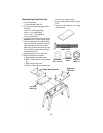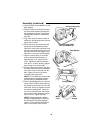
5
- Running the lathe too fast, so that
it vibrates, could cause the work-
piece to be thrown from the
lathe... or the turning tool to be
jerked from your hands.
Always revolve the workpiece by
hand before turning on the motor. If
the workpiece strikes the tool rest, it
could split and be thrown out of the
lathe.
Do not allow the turning tool to "bite"
into the workpiece which could result in
splitting of the workpiece or the work-
piece being thrown from the lathe.
- Always position the tool rest
above the centerline of the lathe
for spindle turning.
- Do not apply the turning tool to
the workpiece below the level of
the tool rest.
Do not run the lathe in the wrong
direction. This could cause the turn-
ing tool to be thrown from your hands.
The lathe must run in a direction so
that the top of the workpiece turns
toward you.
Before attaching a workpiece to the
faceplate:
- Always "rough it out" to as "true
round" as possible. This will mini-
mize vibration while turning.
- Always fasten the workpiece
securely to the face-plate.
- Failure to perform these set-up
operations could cause the work-
piece to be thrown from the lathe.
Avoid awkward hand positions, where
a sudden slip could cause a hand to
move into the workpiece.
Remove all loose knots before install-
ing workpiece between centers or on
the faceplate.
Never leave the lathe work area with
the power on, before the lathe has
come to a complete stop, or without
removing and storing the switch key.
Never operate the lathe with protec-
tive cover on the unused shaft end of
the motor removed.
Hang your turning tools on the wall
toward the tailstock end of the lathe.
Do not lay them on the bench so that
you must reach over the revolving
workpiece to select them.
Keep firm hold and control of the turn-
ing tool at all times. Special caution
must be exercised when knots or
voids are exposed to the turning tool.
Plan Ahead To Protect Your Eyes, Hands, Face and Ears
Reduce the Risk of Accidental
Starting.
• Make sure switch is “OFF” before
plugging lathe into a power outlet.
Dress for safety.
• Any power tool can throw foreign
objects into the eyes. This can result
in permanent eye damage. Always
wear safety goggles, not glasses
complying with ANSI Z87.1 (or in
Canada CSA Z94.3-99) shown on
package. Everyday eyeglasses
have only impact resistant lenses.
They are not safety glasses. Safety
goggles are available at many local
retail stores. Glasses or goggles not
in compliance with ANSI or CSA
could seriously hurt you when they
break.
• For dusty operations, wear a dust
mask along with safety goggles.


















